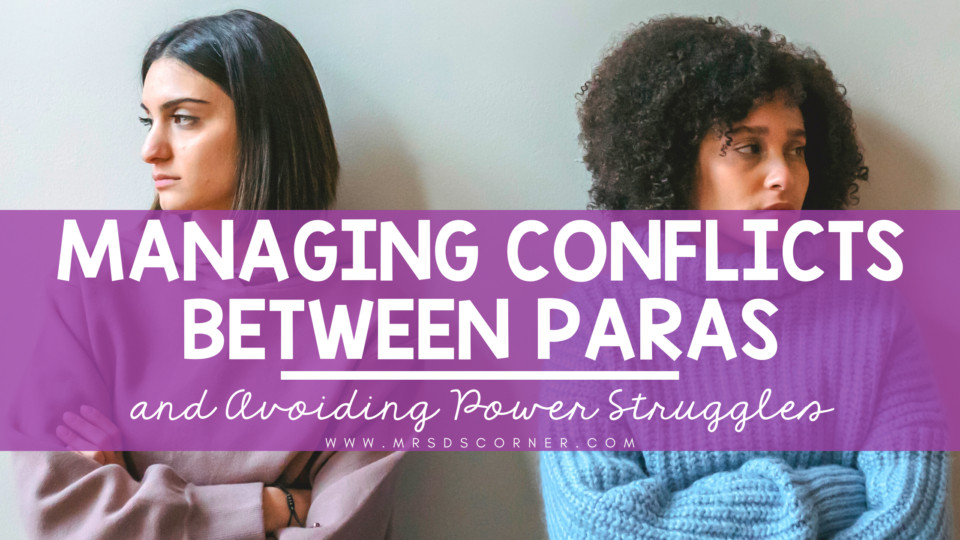Special education teachers play a critical role in supporting students with diverse learning needs, often working closely with paraprofessionals to provide individualized support and instruction. However, conflicts between paraprofessionals and other members of the special education team can sometimes arise, leading to tension, frustration, and even power struggles.


In this article, we will explore some strategies for managing conflict between paraprofessionals, between paraprofessionals and special ed teachers, and how to avoid power struggles with paras.
Whose Job Is It?
Before we get into ideas for managing conflicts between and with paras, it is important to understand who is responsible for supervision. In some districts, special education teachers supervise the paras in their classrooms and are responsible for managing conflicts and other conduct issues.
However, in most schools, paras are supervised not by the special or general education teachers they work with but by the special education coordinator for the building or district. The school principals also supervise and manage issues that arise between and with paras.
By understanding whose job it is to manage the conflicts, teachers and staff can avoid power struggles with paraprofessionals simply by staying out of the issue or referring it to the person responsible for it.
Managing Conflict Between Paraprofessionals
One of the most common sources of conflict between paraprofessionals arises from differences in opinion or approach to supporting students.
To manage this type of conflict, it’s important to establish clear expectations and guidelines for paraprofessional roles and responsibilities. This can include creating clear job descriptions, outlining specific duties and tasks, and setting expectations for communication and collaboration.
In addition to establishing clear guidelines, it’s also important to foster open and transparent communication between paraprofessionals. Encourage paraprofessionals to share their perspectives and concerns and be receptive to feedback and suggestions for improvement. Providing opportunities for professional development and training can also help paraprofessionals develop the skills and knowledge they need to work effectively with students and other members of the special education team.
Another area where conflict arises is when one para is not doing the job assigned while another is picking up the slack for their non-performance. This type of conflict can quickly escalate and cause a tense situation in the classroom. To address this type of concern, it is best to bring in a third party who has the authority to make decisions about the para’s behavior and employment.
Managing Conflict Between Paraprofessionals and Special Education Teachers
Another source of conflict in special education classrooms is between paraprofessionals and special education teachers. This can arise from differences in opinion about instructional strategies, classroom management, or student needs. To manage this type of conflict, it’s important to establish clear lines of communication and collaboration between teachers and paraprofessionals.
Regular team meetings and check-ins can help ensure that everyone is on the same page when it comes to student goals, instructional strategies, and behavior management. Encouraging open dialogue and mutual respect can also help to foster positive working relationships between special education teachers and paraprofessionals.
That being said, it is also important that paras recognize that the authority in the classroom and the final say on matters of instruction and classroom management are the special education teacher’s. Sometimes paras overstep their authority, and that can lead to tension.
Avoiding Power Struggles with Paras
Power struggles between paraprofessionals and other members of the special education team can be particularly challenging to manage.
It’s important to establish clear boundaries and expectations for paraprofessional roles and responsibilities to avoid power struggles. This can include defining specific tasks and duties, setting limits on decision-making authority, and establishing clear channels for communication and collaboration.
It’s also important to ensure that paraprofessionals are given the support and resources they need to be successful in their roles. This can include providing ongoing training and professional development, offering regular feedback and support, and recognizing and rewarding their contributions to the team.
Sometimes paras find themselves in power struggles because they simply do not have the training that they need in order to understand the scope of their work. Taking the time to train them on procedures can make a huge difference in their interactions.
Conflicts Between Paras and the Team
Conflicts between paraprofessionals and other special education team members are a common challenge in special education classrooms. Special education teachers can effectively manage conflicts and build positive working relationships with paraprofessionals by establishing clear guidelines and expectations, fostering open communication and collaboration, and providing ongoing support and resources. Ultimately, this can benefit students with diverse learning needs, helping them to achieve their full potential in the classroom and beyond.

